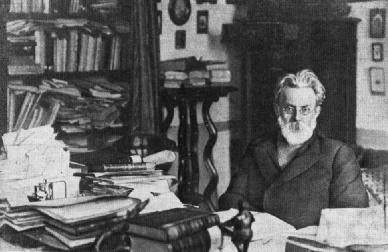Русский English
Outstanding Russian scientists
Ecology
Coasts
Sea of Azov
Kerchenskiy proliv
The Black sea
Outstanding
Russian
scientists
Scientific support
Rest
information
Contacts
Guests
Vladimir Ivanovich Vernadskiy

Vernadskiy Vladimir Ivanovich
(12.3.1863-6.1.1945)
Russian (Soviet) naturalist – chemist, mineralogist and crystallograph, academician (since 1912), academician of Academy of Science Of Ukraine Soviet Socialist Republic (since 1919), its first president (1919-1921).
Vladimir Ivanovich was born in Petersburg. In 1885 he was graduated from Petersburg University. Since 1886 till 1888 he was working in the Museum of Mineralogy of Petersburg University. In 1889-1890 he was improving his education in Italy, Germany and France. In 1890-1911 he was teaching in Moscow University (since 1898 – professor). He left University as a sign of protest against reactionary politics of Russian government. Since 1914 Vernadskiy was a director of Geological and Mineralogical Museum of Academy of Science. In 1922-1939 he became a director of Radium Institute established by himself (in 1922-1926 he delivered the lectures abroad) and at the same time he was a director of the laboratory of the geochemical problems of Academy of Science of USSR, which was reestablished in 1947 as an Institute of geochemistry and analytical chemistry of Academy of Science of USSR. In 1919 he organized the chemical laboratory in Kiev, which in 1931 was reorganized in an Institute of general and inorganic chemistry of Academy of Science of Ukraine. In 1915-1930 he was a chairman of Commission of investigating of natural productive forces of Russia.
The investigations of Vladimir Ivanovich Vernadskiy covered the wide range of problems of natural science: general geochemistry; a silicate structure; geochemistry of rare and diffused elements; a search of radioactive elements; a role of living organisms in geochemical processes; a determination of the absolute age of rocks and so on. In the monographs “An experience of describing mineralogy” (1908-1922) and “The history of minerals of Earth crust” (1923-1936) V.I.Vernadskiy proposed the evolution theory of the mineral origin – so called genetic mineralogy. In 1909 V.I.Vernadskiy generalized the data about parageneze of chemical elements in the Earth crust. He developed an idea about role of kaoline nucleus in the aluminosilicate structure. He brought significance contribution to the theory of isomorphism and the problem of isomorphic rows. He investigated the composition of the Earth crust, ocean and atmosphere. Since 1910 he performed the searches of deposits of radioactive elements and investigated them to determine the uranium and radium content. In the work “Geochemistry essays” (1927) he stated the history of silicon and silicates, manganese, bromine, iodine, carbon and radioactive substances as the sources of energy. He regarded the water as mineral, and created its mineralogy. V.I.Vernadskiy was a founder of biogeochemistry. The totality of living organisms was called by him as “living substance”. According to his ideas, the living substance involves inorganic matter in the continued circulation by means of sun light. He investigated the chemical composition and distribution of animal and vegetable organisms in order to find out their role in the migration of chemical elements in the Earth crust. He pointed to the existence of organisms, which concentrate Fe, Si, Ca, V and other.
1. Outstanding chemists of the world. V.A.Volkov, E.V.Vonskiy, G.I.Kuznetsova. Moscow: publishing house “High School”. 1991. 656 p. In Russian.